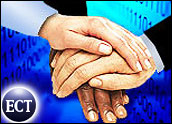
Web service1.A Web service is a software system identified by a URI [RFC 2396], whose public interfaces and bindings are defined and described using XML. Its definition can be discovered by other software systems. These systems may then interact with the Web service in a manner prescribed by its definition, using XML based messages conveyed by Internet protocols.
–World Wide Web Consortium definition
Say what? As clear as the W3C definition may seem to highly technical IT wizards, the concept of Web services continues to elude the rest of the world, masking the massive promise this technology holds for e-business.
After all, Web services perform some impressive functions. In plain English, they allow a company to link its applications with those of its partners, customers and suppliers via the Internet, in much the same way that Web pages are linked together. Therefore, businesses can view and use partners’ information as if it were their own.
In the same vein, companies also can link their own applications within the enterprise — even those coded in different programming languages — to reduce redundancy and increase efficiency. For example, a corporation might link inventory programs with accounting applications so that changes made in one area automatically affect data in other departments.
One Solution To Connect Them All
Columnist Bradley Brown looked at Web services another way, describing their significance as similar to the impact of the RCA phono jack on home stereo systems. Standardization of the jack allowed audio enthusiasts to piece together the best parts of a system — cassette player, 8-track, turntable and receiver — rather than using cumbersome all-in-one players or trying to string together components that required competing inputs.
The same model applies to Web services, which are designed to tie together heterogeneous applications across platforms and servers. Both software and hardware companies — particularly IBM and Microsoft — have taken up the torch in the last two years, pushing protocols and establishing standards to encourage Web services development.
“We’re anticipating that Web services will enable a program to link to another program across the Web so it becomes a Web of applications, of programs, that are interwoven in functionality,” Steve Holbrook, IBM program director for emerging e-business, told the E-Commerce Times.
Long Time Coming
Web services did not arrive overnight; they have been in development for several years. The underlying key to the technology is extensible markup language, or XML, which serves as a translator between applications. XML can be used across all platforms and operating systems, regardless of programming language.
The other major driver of Web services is known as simple object access protocol, or SOAP. This technology enables transmission of XML messages between different applications over HTTP (the protocol on which the World Wide Web is based). Yet another standard, Web Services Description Language, or WSDL, is used to create the user interface.
Anticipated revenue potential is substantial, with a US$21 billion boost predicted in the software, services and hardware markets by 2007, according to research firm IDC. For now, the numbers are less eye-popping. IDC has estimated that just 5 percent of U.S. businesses in 2002 had completed a Web services project. But that figure is expected to grow. By 2008, the research firm said, 80 percent of firms will have such a project under way.
Benefits of a New E-Economy
Hype aside, adoption of Web services really will dramatically alter the way business is conducted. Drew Engstrom, senior marketing strategist for Web services at Sun Microsystems, said he believes that as the economy shifts from an asset-based to an information-based one, Web services will enable different and more varied types of partnerships between businesses.
Engstrom told the E-Commerce Times that communication about ordering, fulfillment, billing and inventory among partners, suppliers and customers will become seamless, automatic and cost-efficient.
“I think all companies are going to have to face that differentiation is not going to come from a better product, necessarily, but in how you leverage the information around that product, how you put it into the context of a service, and how you deliver that product,” he noted.
He cited the example of Amazon.com, whose assets are not necessarily the books stored in a warehouse, but rather the information collected about customers and the architecture used to leverage such information by providing features like personalized product recommendations.
‘Better, Faster, Cheaper’
For his part, Giga Information Group analyst Mike Gilpin told the E-Commerce Times that low-cost and ubiquitous connectivity among and within companies “will accelerate the handling of customer requests, lower the cost of performing those transactions, and enable bigger players to offer more highly specialized services.” These processes will be automated, he explained, rather than dependent on employees for their execution.
And Forrester analyst Ted Schadler summed it up by saying: “It’s about better, faster, cheaper customer relationships or supplier relationships.”
Perhaps the best way to understand Web services’ impact on e-business is to examine successful implementations. For example, online travel booking service Expedia uses Web services to help deliver flight status information and other travel data to customers’ PCs or mobile phones. And Zagat Survey implemented Web services to reduce the costs of sending monthly database updates of its restaurant reviews to its content partners in 45 cities.
Stacking Up
So, what is coming down the pike in the future? IBM, Sun and analysts all pointed to Web “stacks” as a development that could affect how much Web services can deliver.
“It’s the idea of baking a little workflow into Web services standards,” Sun’s Engstrom said. Web stacks “might have some process logic, like, ‘If I send you an order for 1,000 widget boxes and you only have 500, you have to send a message back stating that.'”
IBM’s Holbrook said he believes standards bodies, including the W3C, will not agree on stack protocols until 2005. But in the long run, he seems optimistic about Web services.
“One way of looking at Web services is that it’s EDI for the masses,” he said. “[EDI] attempted to do automation, but it was a high hurdle to clear, and it required some major investments, which were insurmountable for a lot of small businesses. Web services is much more attainable.”











































I AM AM azed to see how little the subject of "digital identity" is discussed within the "Web Service" subject. Make no mistake, there will not be a broad uptake of "Web Services" without better security/authentication. The PC OEM’s are about to deploy TCPA compliant PC’s that are a step in the right direction. But without a managed "Trust Infrastructure" how are we going to do life cycle managed of all the TCPA boxes out there?
Questions, questions…
awk